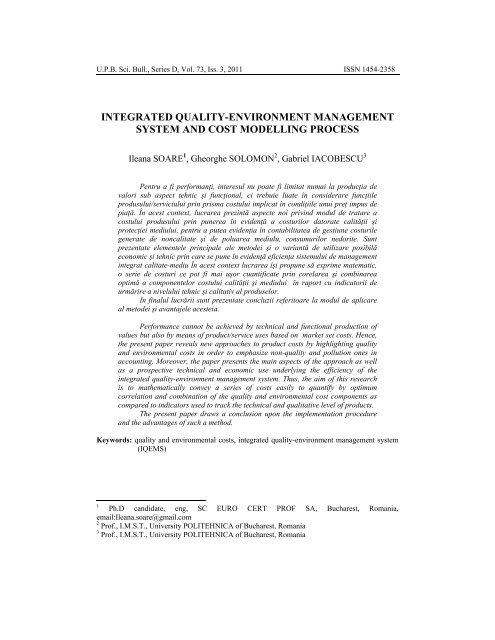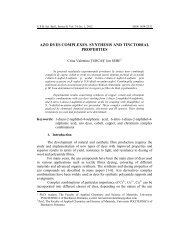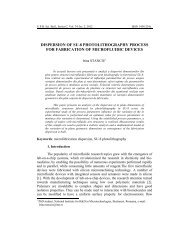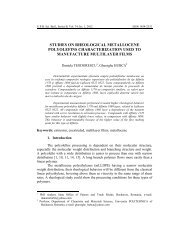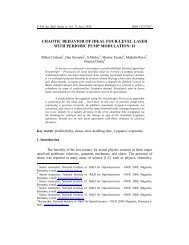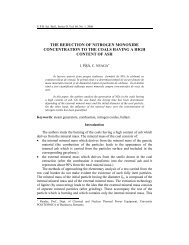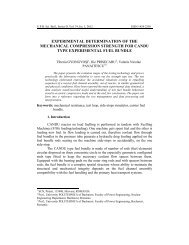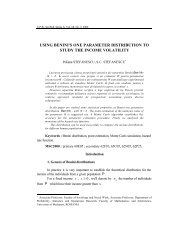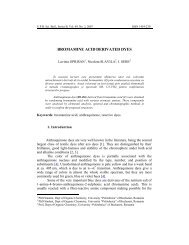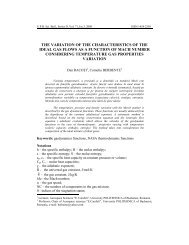integrated quality-environment management ... - Scientific Bulletin
integrated quality-environment management ... - Scientific Bulletin
integrated quality-environment management ... - Scientific Bulletin
You also want an ePaper? Increase the reach of your titles
YUMPU automatically turns print PDFs into web optimized ePapers that Google loves.
U.P.B. Sci. Bull., Series D, Vol. 73, Iss. 3, 2011 ISSN 1454-2358<br />
INTEGRATED QUALITY-ENVIRONMENT MANAGEMENT<br />
SYSTEM AND COST MODELLING PROCESS<br />
Ileana SOARE 1 , Gheorghe SOLOMON 2 , Gabriel IACOBESCU 3<br />
Pentru a fi performanţi, interesul nu poate fi limitat numai la producţia de<br />
valori sub aspect tehnic şi funcţional, ci trebuie luate în considerare funcţiile<br />
produsului/serviciului prin prisma costului implicat în condiţiile unui preţ impus de<br />
piaţă. În acest context, lucrarea prezintă aspecte noi privind modul de tratare a<br />
costului produsului prin punerea în evidenţă a costurilor datorate calităţii şi<br />
protecţiei mediului, pentru a putea evidenţia în contabilitatea de gestiune costurile<br />
generate de noncalitate şi de poluarea mediulu, consumurilor nedorite. Sunt<br />
prezentate elementele principale ale metodei şi o variantă de utilizare posibilă<br />
economic şi tehnic prin care se pune în evidenţă eficienţa sistemului de <strong>management</strong><br />
integrat calitate-mediu În acest context lucrarea îşi propune să exprime matematic,<br />
o serie de costuri ce pot fi mai uşor cuantificate prin corelarea şi combinarea<br />
optimă a componentelor costului calităţii şi mediului în raport cu indicatorii de<br />
urmărire a nivelului tehnic şi calitativ al produselor.<br />
In finalul lucrării sunt prezentate concluzii referitoare la modul de aplicare<br />
al metodei şi avantajele acesteia.<br />
Performance cannot be achieved by technical and functional production of<br />
values but also by means of product/service uses based on market set costs. Hence,<br />
the present paper reveals new approaches to product costs by highlighting <strong>quality</strong><br />
and <strong>environment</strong>al costs in order to emphasize non-<strong>quality</strong> and pollution ones in<br />
accounting. Moreover, the paper presents the main aspects of the approach as well<br />
as a prospective technical and economic use underlying the efficiency of the<br />
<strong>integrated</strong> <strong>quality</strong>-<strong>environment</strong> <strong>management</strong> system. Thus, the aim of this research<br />
is to mathematically convey a series of costs easily to quantify by optimum<br />
correlation and combination of the <strong>quality</strong> and <strong>environment</strong>al cost components as<br />
compared to indicators used to track the technical and qualitative level of products.<br />
The present paper draws a conclusion upon the implementation procedure<br />
and the advantages of such a method.<br />
Keywords: <strong>quality</strong> and <strong>environment</strong>al costs, <strong>integrated</strong> <strong>quality</strong>-<strong>environment</strong> <strong>management</strong> system<br />
(IQEMS)<br />
1<br />
Ph.D candidate, eng, SC EURO CERT PROF SA, Bucharest, Romania,<br />
email:Ileana.soare@gmail.com<br />
2 Prof., I.M.S.T., University POLITEHNICA of Bucharest, Romania<br />
3 Prof., I.M.S.T., University POLITEHNICA of Bucharest, Romania
252 Ileana Soare, Gheorghe Solomon, Gabriel Iacobescu<br />
1. Introduction<br />
The reduction of both total <strong>quality</strong> and <strong>environment</strong>al costs represents one<br />
of the main objectives of <strong>management</strong> in order to ensure the success and profit of<br />
the company. Within production systems, product/service check-ups, personnel’s<br />
pro-active attitude towards the prevention of production flaws, defect products<br />
remedies, defects corrective measures, complaints handling processes may<br />
increase costs and decrease the profit. Hence, there is a must for a correct<br />
distribution of conformity costs as well as of those likely to reduce nonconformity.<br />
Non-<strong>quality</strong> costs are considered the result of typical flaws of<br />
purchased materials and production processes [1].<br />
Our research deals with a model for the optimization of costs for a<br />
production system based on an <strong>integrated</strong> <strong>quality</strong>-<strong>environment</strong> <strong>management</strong><br />
system to be monitored by means of stock-accounting. Thus, real data can be used<br />
to analyze the efficiency of an <strong>integrated</strong> <strong>quality</strong>-<strong>environment</strong> <strong>management</strong><br />
system as well as its continuous improvement.<br />
2. Costs- Based Total Cost Modelling Set by IQEMS<br />
Since IQEMS and technological processes are linked together in order to<br />
highlight <strong>quality</strong> and <strong>environment</strong>al costs, the present paper suggests a two<br />
method combination approach [1].<br />
Thus, there are two method combination approaches of cost:<br />
- Calculation target-costing;<br />
- Estimated costing assessment.<br />
• Calculation target-costing –that sets global cost for the product lifecycle,<br />
implies the following stages:<br />
- Stage 1 – target costing setup: mainly determined by market analysis<br />
and its main objective is the product lifecycle.<br />
PGprod = PVprod + PMprod<br />
(1)<br />
PMprod = PMprod g + PMprod pg + PSprodc<br />
(2)<br />
where:<br />
- PGprod – global product cost for the entire lifecycle<br />
- PVprod – product selling price<br />
- PMprod – product maintenance price for the entire lifecycle (from<br />
startup to shut-down).<br />
- PMprod g – product maintenance price during warranty.<br />
- PMprod pg - product maintenance price for after warranty.
Cost modelling process of the <strong>integrated</strong> <strong>quality</strong>-<strong>environment</strong>al <strong>management</strong> system 253<br />
- PSprod c – shut-down price (product disuse and reuse).<br />
- Stage 2 – target profit setup: based on the strategic planning fixed by the<br />
company on a medium run and on the range of similar competition<br />
products.<br />
- Stage 3 – target costing setup provided by the difference between target<br />
costing and target profit.<br />
CTprod = PVprod − PFprod<br />
(3)<br />
where:<br />
- CTprod – poduct total target cost<br />
- PVprod – product selling price<br />
- PFprod –target profit per product<br />
- Stage 4 – product organic breakdown based on its physical structure.<br />
- Stage 5 – functional breakdown based on product analysis, taking into<br />
account the client’s reiterated needs. The relation value-cost is optimized and<br />
defined as the capacity of a company to produce the required product, with its<br />
precise corresponding functions in accordance with the target costs.<br />
• Estimated costing assessment – represents the total cost calculated by<br />
means of accounting data, when existing products are updated and planning data,<br />
when a new product is launched.<br />
The method proposed to be used in order to assess the estimated costing as<br />
well as to monitor the costs within an <strong>integrated</strong> <strong>quality</strong>-<strong>environment</strong> <strong>management</strong><br />
system is the calculation of process costs or per activity (ABC) in order to deal<br />
with processes or activities/operations for which defect costs are too high and<br />
analyze causes and take corrective measures necessary to sort them out. ABC<br />
method combines with the aforementioned IQEMS cost method. Hence, the<br />
following stages are to be considered:<br />
- Activity analysis and process hierarchy setup:<br />
(i) Determination of the production flow diagram by means of<br />
direct, indirect or collateral processes, taking into account IQEMS implications by<br />
production stages;<br />
(ii) Hypothesis elaboration regarding the technical and IQEMS<br />
processes.<br />
(iii) Determination of technical and economic risks regarding<br />
<strong>quality</strong> – <strong>environment</strong>al requirements;<br />
(iv) Determination of importance criteria in view of classifying<br />
process-based production.<br />
(v) Determination of indicators used to track the technical,<br />
qualitative and <strong>environment</strong>al level of products.<br />
(vi) Activity analysis and process classification – based<br />
production.
254 Ileana Soare, Gheorghe Solomon, Gabriel Iacobescu<br />
(vii) Capacities and costs allocation.<br />
(viii) Realization of processes resulting from breakdowns.<br />
(ix) Classification of breakdowns within the main processes.<br />
- Cost structure setup according to their distribution<br />
- Production costs setup within an <strong>integrated</strong> <strong>quality</strong>-<strong>environment</strong><br />
<strong>management</strong> system<br />
- Setup of divided costs<br />
- Cost structure setup according to the type of process<br />
- Setup of IQEMS monitoring cost structure<br />
- Setup of cost indicators and quantitative structures:<br />
(i) Setup of reference dimensions underlying common, indirect<br />
costs distribution<br />
(ii) Setup of criteria to determine reference dimensions<br />
(iii)Setup of quantitative structures.<br />
- Determination of quota for process/activity costs:<br />
(iv) Determination of costs quota for processes based on the<br />
achieved volume - kv i<br />
CP(<br />
i)<br />
kv i = (4)<br />
KP(<br />
i)<br />
where:<br />
CP(i) = costs for process “i”.<br />
KP(i) = process quantity used for the realization of “i”.<br />
(v) Determination of distribution process quota as compared to<br />
the respective volumes - kr i.<br />
CP(<br />
i)<br />
kr i = × 100<br />
(5)<br />
CPC(<br />
i)<br />
where:<br />
kr i = distribution cost quota for process “i”<br />
CP(i) = costs for the neutral process “i”.<br />
CPC(i) = “i” process costs regardless of the achieved<br />
product/services quantities.<br />
Calculation of the total cost quota for a production process – resulting<br />
from summing up volume based cost quotas and distribution – additional based<br />
ones -kt i<br />
kt i = kvi<br />
+ kri<br />
(6)
Cost modelling process of the <strong>integrated</strong> <strong>quality</strong>-<strong>environment</strong>al <strong>management</strong> system 255<br />
3. Production costs structure within an <strong>integrated</strong> <strong>quality</strong><strong>environment</strong><br />
<strong>management</strong> system<br />
The costs in the function to IQEMS can be structured in the following<br />
way:<br />
• Environment-<strong>quality</strong> common costs – CCqm<br />
• Quality specific costs –CSq<br />
• Environmental specific costs – CSm<br />
The following formula results:<br />
CTqm = CCqm + CSq + CSm<br />
(7)<br />
where:<br />
CTqm= total costs generated to the IQEMS<br />
In the following, these costs are coined as IQEMS structure costs.<br />
Structure of Process Divided Costs<br />
We propose the following formula for the IQEMS costs structure [2]:<br />
• CP- process cost<br />
• CSP – subprocess cost<br />
• CAsp – activity cost /subprocess operation cost<br />
n<br />
CP ( i ) = ∑ Kj 1 × CSP ( j1<br />
)<br />
(8)<br />
j = 1<br />
1<br />
n<br />
CSP (9)<br />
∑<br />
= 1 j CAsp( j<br />
1<br />
2 )<br />
j2<br />
n1<br />
n 2<br />
( i ) = ∑ K ( j1<br />
) • ∑ CAsp ( j2<br />
j1<br />
= 1 j 2<br />
CP )<br />
(10)<br />
where:<br />
• K(j 1 ) – coefficient of process weight - which represents unitary quotas<br />
to subprocess costs<br />
• j 1 - subprocess code<br />
• j 2 - activity code<br />
These costs are named process divided costs.<br />
4. Costs structure setup based on process type<br />
Processes can be classified in:<br />
• Management system process - where CPqm – IQEMS process cost
256 Ileana Soare, Gheorghe Solomon, Gabriel Iacobescu<br />
• Specific process of product/service for product realization –named<br />
technology process (ex. Soldering process) – where CPth – technology process<br />
cost<br />
CTprod j = CTqm + CTPth<br />
(11)<br />
3 j3<br />
j3<br />
where:<br />
CTprod – product/service total cost<br />
j 3 – product/service code<br />
CTqm j3 =total cost generated by application and monitoring of IQEMS<br />
for one product, what it represents a quota of the system implementation and<br />
project total costs, and it can have the following formula:<br />
CTqm j = k j × CTqm = k1<br />
j × CCqm + k2<br />
j × CSq + k3<br />
j × CSm<br />
3 3<br />
3<br />
3<br />
3<br />
where:<br />
k j3 ,k1 j3 , k2 j3 , k3 j3 IQESM costs quota coefficient for types of products<br />
(12)<br />
k j<br />
3<br />
=<br />
k1<br />
j3 × CCqm + k2<br />
j3<br />
× CSq + k3<br />
j3<br />
× CSm<br />
CTqm<br />
(13)<br />
and<br />
n<br />
CTPth j = ∑CPth(<br />
i)<br />
(14)<br />
3<br />
i=<br />
1<br />
where:<br />
CTPth = total costs generated by technology processes in product<br />
realization j 3<br />
i = technology process code<br />
Costs correlated formula between the costs generated by IQEMS and the<br />
total cost of the product, which may take the following form:<br />
n<br />
CTprod j = k j × CTqm + ∑CPth(<br />
i)<br />
=<br />
3 3<br />
i=<br />
1<br />
n<br />
= k1<br />
j × CCqm + k2<br />
j × CSq + k3<br />
j × CSm + ∑CPth(<br />
i)<br />
3<br />
3<br />
3<br />
i=<br />
1<br />
(15)
Cost modelling process of the <strong>integrated</strong> <strong>quality</strong>-<strong>environment</strong>al <strong>management</strong> system 257<br />
costs<br />
5. Structure of IQEMS monitoring costs– <strong>environment</strong>al and <strong>quality</strong><br />
Due to the implications of the actions used in IQEMS application and<br />
monitoring, the costs can be divided in [3]:<br />
• Preventive action costs –noted CMS(1)<br />
• Appraisal costs (monitoring, measuring and analysing)- noted CMS(2)<br />
• Correction costs of the intern deviation– noted CMS(3)<br />
• Corrective action costs of the intern deviation–noted CMS(4)<br />
• Correction costs of the external deviation -noted CMS(5)<br />
• Corrective action costs for the external deviation – noted CMS(6)<br />
In order to simplify the formula, we have used the noted CMS –<br />
monitoring costs system.<br />
6<br />
6<br />
6<br />
6<br />
CTMS = ∑CMS(<br />
j4)<br />
= ∑CMSqmj<br />
( 4)<br />
+ ∑CMSq(<br />
j4)<br />
+ ∑CMSm(<br />
j4)<br />
(16)<br />
j4=<br />
1<br />
j4= 1<br />
j4= 1<br />
j4=<br />
1<br />
where :<br />
j 4 = IQEMS monitoring costs type, and j 4<br />
∈ {1÷6}<br />
CTSM = system monitoring total costs<br />
6. The structure of the costs based on the distribution mode in the<br />
administration accountancy.<br />
Regarding the distribution mode in the administration accountancy, the<br />
product costs are structured according to product direct costs, noted CDprod and<br />
product direct costs, noted CIprod<br />
and:<br />
CTprod = CDprod + CIprod<br />
(17)<br />
where:<br />
n<br />
CDprod = ∑ m1<br />
( i1<br />
) × CP(<br />
i1<br />
)<br />
(18)<br />
i1<br />
and<br />
n<br />
CIprod = ∑ m2<br />
( i1<br />
) × CP(<br />
i1<br />
)<br />
(19)<br />
i1<br />
The following formulae have been used to obtain the costs structure<br />
according to process types used in production: formula (17), formula (18),<br />
formula (19) and formula (9).
258 Ileana Soare, Gheorghe Solomon, Gabriel Iacobescu<br />
CTprod =<br />
=<br />
n<br />
m1<br />
( i1<br />
) × CP(<br />
i1<br />
) +<br />
i<br />
∑<br />
1<br />
∑[ m1<br />
( i1<br />
) + m2<br />
( i1<br />
)] × CP(<br />
i1<br />
)<br />
n<br />
m2<br />
( i1<br />
) × CP(<br />
i1<br />
) =<br />
i<br />
∑<br />
1<br />
(20)<br />
where:<br />
i. m 1 (i 1 ), m 2 (i 1 ) – coefficients of processes weight<br />
ii. CP(i 1 ) – process cost<br />
iii. i 1 – process code<br />
iv. process examples: human resources <strong>management</strong>, purchasing<br />
<strong>management</strong>, infrastructure <strong>management</strong>, welding process) .<br />
7. Product/service costs calculation based on cost modeling process of<br />
an Integated Quality-Environment Management System<br />
The calculation of costs must provide previous and further information<br />
about product processes costs that have been used, the working place as well as<br />
about products, services, places and processes that the costs imply [4] .<br />
This information is derived from formula (1) ÷ (16) used in order to obtain<br />
the structure of the product costs based on process types and IQEMS applications.<br />
Combining both formula (20) and formula (10), we obtain a costs structure<br />
for product realization based on process types.<br />
/ /<br />
// //<br />
[ m i ) + m ( i )] × CPth(<br />
i ) + [ m ( i ) + m ( i )] × CTqm(<br />
i )<br />
n<br />
CTprod = 1 ( 1 2 1 1 ∑ 1 1 2 1<br />
1<br />
i<br />
∑ (21)<br />
1<br />
According to formula (21) and formula (12) and (16), we obtain a<br />
structure of the product realization costs based on process types costs divided in<br />
IQEMS monitoring costs– (<strong>environment</strong>al and <strong>quality</strong> costs)
Cost modelling process of the <strong>integrated</strong> <strong>quality</strong>-<strong>environment</strong>al <strong>management</strong> system 259<br />
CTprod<br />
n<br />
n<br />
/ /<br />
// //<br />
[ m ( i ) + m ( i )] × CPth(<br />
i ) + [ m ( i ) + m ( i )]<br />
∑ [ k1(<br />
i2<br />
) × CCqm ( i2<br />
) + k2<br />
( i2<br />
) × CSq(<br />
i2<br />
) + k3<br />
( i2<br />
) × CSm(<br />
i2<br />
)]<br />
i<br />
=<br />
1<br />
2<br />
n<br />
∑<br />
i<br />
n<br />
×<br />
i<br />
1<br />
∑<br />
2<br />
1<br />
=<br />
∑<br />
1<br />
n<br />
/ /<br />
// //<br />
[ m ( i ) + m ( i )] × CPth(<br />
i ) + [ m ( i ) + m ( i )]<br />
1<br />
1<br />
n<br />
i<br />
1<br />
2<br />
1<br />
1<br />
2<br />
1<br />
1<br />
∑<br />
⎡ 6<br />
6<br />
⎤<br />
⎢k1(<br />
i2<br />
) × ∑ CMSqm ( i2<br />
, j4<br />
) + k2<br />
( i2<br />
) × ∑ CMSq ( i2<br />
, j4<br />
) + ⎥<br />
⎢ j =<br />
=<br />
⎥<br />
4 1<br />
j4<br />
1<br />
⎢<br />
⎥<br />
⎢<br />
6<br />
⎥<br />
⎢+<br />
k3<br />
( i2<br />
) × ∑ CMSm ( i2<br />
, j4<br />
)<br />
⎥<br />
⎢⎣<br />
j4<br />
= 1<br />
⎥⎦<br />
i<br />
1<br />
1<br />
1<br />
∑<br />
1<br />
i<br />
1<br />
1<br />
2<br />
1<br />
1<br />
×<br />
2<br />
1<br />
=<br />
×<br />
(22)<br />
9. Conclusions<br />
The above outlined cost calculation models of a product by means of an<br />
<strong>integrated</strong> <strong>quality</strong>-<strong>environment</strong> <strong>management</strong> system allows their corresponding<br />
recording by means of internal stock accounting. They can be classified according<br />
to process importance in product/service realization. Hence, there can be clearly<br />
depicted the efficiency of each process per types of expenses, by means of wellknown<br />
methods as stipulated by ISO10017/2005.<br />
This method can be used in order to define costs according to weight<br />
process coefficients for production.<br />
Accounting recording in order to monitor IQEMS reveals various<br />
advantages since it sets the following costs :<br />
• Waste costs<br />
• Remedy costs<br />
• Corrective measures costs to reduce non-conformity<br />
• Costs of materials used for waste and recycling<br />
• Delays costs<br />
• Complaints costs<br />
• Calculation of costs, savings and benefits as provided by<br />
<strong>environment</strong>al projects<br />
• Setup of quantifiable performance targets<br />
• Environmental friendly production, pollution prevention and the<br />
development of <strong>environment</strong>al projects
260 Ileana Soare, Gheorghe Solomon, Gabriel Iacobescu<br />
• Environmental notification<br />
• IQEMS continuous improvement by <strong>quality</strong> and <strong>environment</strong>al<br />
performance assurance of products/services considered the main line of activity.<br />
R E F E R E N C E S<br />
[1] I. Soare, A. D. Colceru, Organizarea şi conducere sistemelor calităţii la nivel de întreprindere<br />
(firmă) (Quality Systems Management and Organization in Enterprises (Companies)), ISBN<br />
973-96711-5-2, pp369-378, Editura Tribuna Economică, 1995 (in Romanian).<br />
[2] K. Ebbeken, L. Possler, M. Ristea, Calculaţia şi <strong>management</strong>ul costurilor (Costs Calculation<br />
and Management), ISBN 973-20-0581-5, pp363-389, Editura Teora, 2000 (in Romanian).<br />
[3] ISO10014:2006 - Quality Management. Guidelines for Economic and Financial Benefits<br />
Achievement.<br />
[4] ISO 9001:2008 – Quality Management Systems. Requirements.


